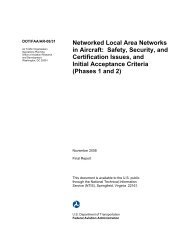Published Report (DOT/FAA/CT-94-36)
Published Report (DOT/FAA/CT-94-36)
Published Report (DOT/FAA/CT-94-36)
You also want an ePaper? Increase the reach of your titles
YUMPU automatically turns print PDFs into web optimized ePapers that Google loves.
lunder rate may be computed. The speeds used in the simulation<br />
ranged from 120 kts to 227 kts. The 120 kts was due to a<br />
blundering aircraft and the 227 kts was due to an evading<br />
aircraft. If is assumed that either aircraft could be traveling<br />
at any speed between these two numbers, then the ratio of speeds<br />
ranges from 120/227 = .53 to 227/120 = 1.89. Using these two<br />
ratios as the minimum and maximum speed ratios and using a<br />
maximum blunder angle of 30°, the maximum window length is 2279<br />
feet. This occurs at the 1.89 ratio. Therefore, the probability<br />
of correct alignment, assuming 3 miles longitudinal separation,<br />
is given by<br />
2279<br />
1<br />
= 0.125 = -<br />
3 x 6076 8<br />
Analysis of the data using the equations derived for the window<br />
of risk, indicated that the number of at-risk aircraft was 186<br />
with two resultant TCVs. Using a .99 confidence interval to<br />
compute the upper bound for the binomial probability, the upper<br />
bound would be 0.049. This would lead to the following ratio of<br />
TCV's to at-risk aircraft:<br />
Another factor needed is the ratio of Worst Case Blunders to 30'<br />
blunders. This really means, the ratio of 30' blunders in which<br />
the pilot of the blundering aircraft is unable to respond to<br />
instructions by the controller. In previous studies, the ratio<br />
of worst case blunders to 30' blunders, based on conversations<br />
with controllers and pilots, has been estimated to be 1/100.<br />
Recent conversations with controllers indicate that the 1/100<br />
ratio may be too large and that the actual rate may be<br />
significantly lower. A more conservative approach would be to<br />
increase the 1/100 ratio, already considered conservative by the<br />
responding controllers, to 1/10. Because of the uncertainty of<br />
the ratio, both conservative estimates will be considered. Since<br />
the target risk is given in accidents per approach, factors must<br />
be introduced to correct for the number of approaches taking<br />
place during a triple approach and for the fact that one<br />
collision is equivalent to two accidents. The equation will be<br />
displayed with appropriate units for the convenience of the<br />
reader.<br />
Using 1/100 as the estimate, the number of acceptable blunders to<br />
achieve the target probability of 4 x 10 or 1 fatal accident in<br />
25 million approaches, becomes<br />
1 ACC 8WCB 102algnWCB 3app lTCV 10030"Bl -<br />
130' Blunder<br />
X- x-x<br />
25 mill app 1 algn WCB 5 TCV 1 triple 2 ACC 1 WCB 1021 triple approaches<br />
L-13

















